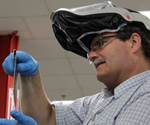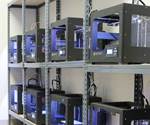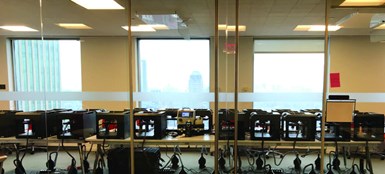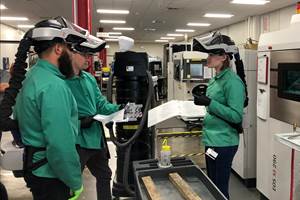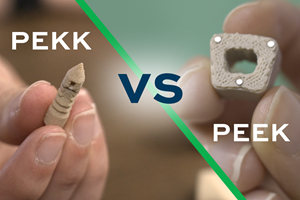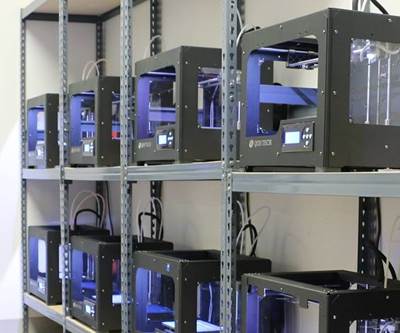NIOSH Publishes 3D Printing Safety Guide for Nonindustrial Settings
NIOSH has published a 3D printing safety guide for small businesses and other additive manufacturing users such as makerspace users, schools, libraries and small businesses.
NIOSH recommends safety measures such as a low-cost air cleaner assembly connected to a modified extruder cover. Source: NIOSH
As the use of 3D printing continues to proliferate beyond the realm of industrial additive manufacturing (AM), the National Institute for Occupational Safety and Health (NIOSH) has been evaluating emissions from different printer and filament combinations operating in both chamber studies and workplace environments to understand the potential health and safety risks. Now, NIOSH has released a report summarizing its findings and recommendations for controls to protect workers using 3D printers in makerspaces, schools, libraries and small businesses.
“Approaches to Safe 3D Printing: A Guide for Makerspace Users, Schools, Libraries and Small Businesses” addresses the risk of potential exposure to ultrafine particles, chemicals and safety hazards related to 3D printing. The document discusses 3D printing technologies commonly used in these spaces, related NIOSH findings and risk management recommendations to protect workers and users from exposure to ultrafine particles, chemicals and safety hazards while using 3D printers.
Here are 20 MakerBot Replicator+ 3D printers equipped with individual local exhaust ventilation (LEV) engineering controls in a conference room. Source: NIOSH
The potential health and safety hazards related to 3D printing vary widely depending on the technology and materials used, as well as where the printers are located and any controls that may be in place. The following are just a few of the many safety tips found in the guide:
- Risk Management Plan — An important first safety step is creating a comprehensive risk management plan for 3D printing that follows the hierarchy of controls (as described in the report). The plan should be readily available and accessible to all students, patrons and employees, including temporary employees, contractors, trainees and other users. The plan should address all aspects of safely using 3D printers and printing materials throughout the facility, and it should specify measures that the facility operator is taking to protect employees and all users. Because chemicals are used in the forms of polymers, resins and solvents, the requirements of the “OSHA Hazard Communication Standard” must be met, including providing safety datasheets (SDSs) and training all affected employees. The plan should characterize the hazards associated with each of the work activities (preprinting, printing, post-printing, postprocessing, maintenance and cleaning) and provide best practices and standard operating procedures to reduce the potential hazards.
- Engineering Controls — These controls are designed to reduce user exposures by removing the hazard from the process or by placing a barrier between the hazard and the user. Properly designed, used and maintained engineering controls protect users effectively without placing primary responsibility of implementation on the user. For example, acceptable room ventilation should help remove particles and maintain a healthy work environment. Some localities may also have specific codes that require mechanical exhaust in addition to room ventilation.
- Enclosures — Engineering controls can also include placing 3D printers inside ventilated enclosures or installing printers under a fume hood or next to a local exhaust to provide source control. NIOSH says that such a strategy is more efficient than general dilution ventilation. Also, NIOSH engineers have developed custom low-cost engineering controls for open-frame desktop 3D printers and made the designs publicly available through the National Institutes of Health website at “NIH 3D” — which is an open-source library of 3D printable designs. These and other retrofit engineering controls can reduce 3D printer emissions, thereby reducing the potential for worker exposures.
- Risk Assessments — Before retrofitting engineering controls are added to 3D printers in the workplace, a qualified safety and health professional should do a risk assessment. The assessment should verify that adding the engineering control does not increase fire risk, violate Nationally Recognized Testing Laboratory (NRTL) approval, void the manufacturer’s warranty, or cause additional safety or health risks. Engineering controls introduced by the manufacturer into the original design of a 3D printer are preferred over retrofit controls.
The report provides a variety of options and considerations to manage the potential occupational health and safety risks in nonindustrial workplaces. Using ventilated enclosures, local exhaust ventilation, administrative controls and PPE can prevent unnecessary exposures, control odors and reduce emissions during 3D printing and associated tasks. For the complete list of NIOSH recommendations, see the report online.
NIOSH researchers have also studied emissions in the 3D printing workplace and shared their approach to eliminate, avoid and reduce operator contact with volatile organic compounds (VOCs) and ultrafine particles from fused filament fabrication (FFF) 3D printers.
Another study, this one from Chemical Insights (part of Underwriters Laboratories), looked at VOCs and particles emitted by resin-style 3D printers, sharing what the results indicate and how to operate machines safely.
It’s important to note that no set of safety recommendations can be a “one-size-fits-all” solution because a variety of 3D printing types, processes and print materials can be used in different frequencies and durations. For more 3D printing safety information from NIOSH, visit the Centers for Disease Control and Prevention website.
Related Content
AM 101: What Is Binder Jetting? (Includes Video)
Binder jetting requires no support structures, is accurate and repeatable, and is said to eliminate dimensional distortion problems common in some high-heat 3D technologies. Here is a look at how binder jetting works and its benefits for additive manufacturing.
Read MoreHow to Pursue a Career in Additive Manufacturing
AM professionals are in demand as 3D printing matures and advances. But what skills are hiring manufacturers looking for? How can applicants prepare? And where can you find relevant job listings?
Read More10 Important Developments in Additive Manufacturing Seen at Formnext 2022 (Includes Video)
The leading trade show dedicated to the advance of industrial 3D printing returned to the scale and energy not seen since before the pandemic. More ceramics, fewer supports structures and finding opportunities in wavelengths — these are just some of the AM advances notable at the show this year.
Read MoreUnderstanding PEKK and PEEK for 3D Printing: The Cool Parts Show Bonus
Both materials offer properties desirable for medical implants, among other applications. In this bonus episode, hear more from Oxford Performance Materials and Curiteva about how these companies are applying PEKK and PEEK, respectively.
Read MoreRead Next
Vat Photopolymerization and VOC Emissions: Study Results and User Guidelines
New research conducted by Chemical Insights, part of Underwriters Laboratories, is studying volatile organic compounds (VOCs) and particles emitted by resin-style 3D printers. Here are what the results indicate and how to operate machines safely.
Read MoreSafety Hazards in Additive Manufacturing
The number-one thing a company can do to protect its AM investment and not interrupt production is develop a comprehensive safety policy specifically for additive.
Read MoreAre Emissions from 3D Printing Hazardous to Your Health?
And if so, what can you do about it? NIOSH researchers share the organization’s approach to eliminate, avoid and reduce operator contact with volatile organic compounds (VOCs) and ultrafine particles from fused filament fabrication (FFF) 3D printers.
Read More


